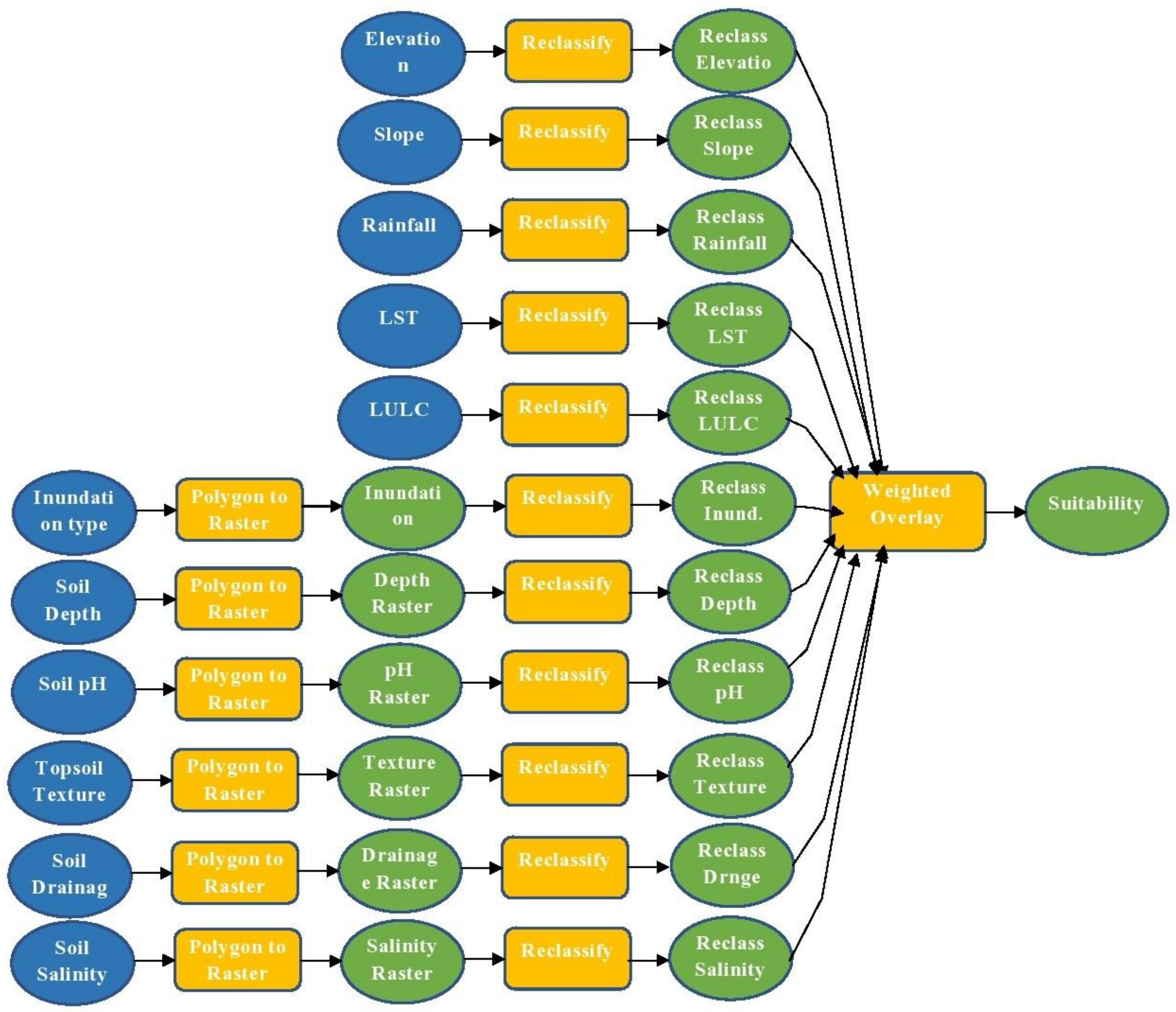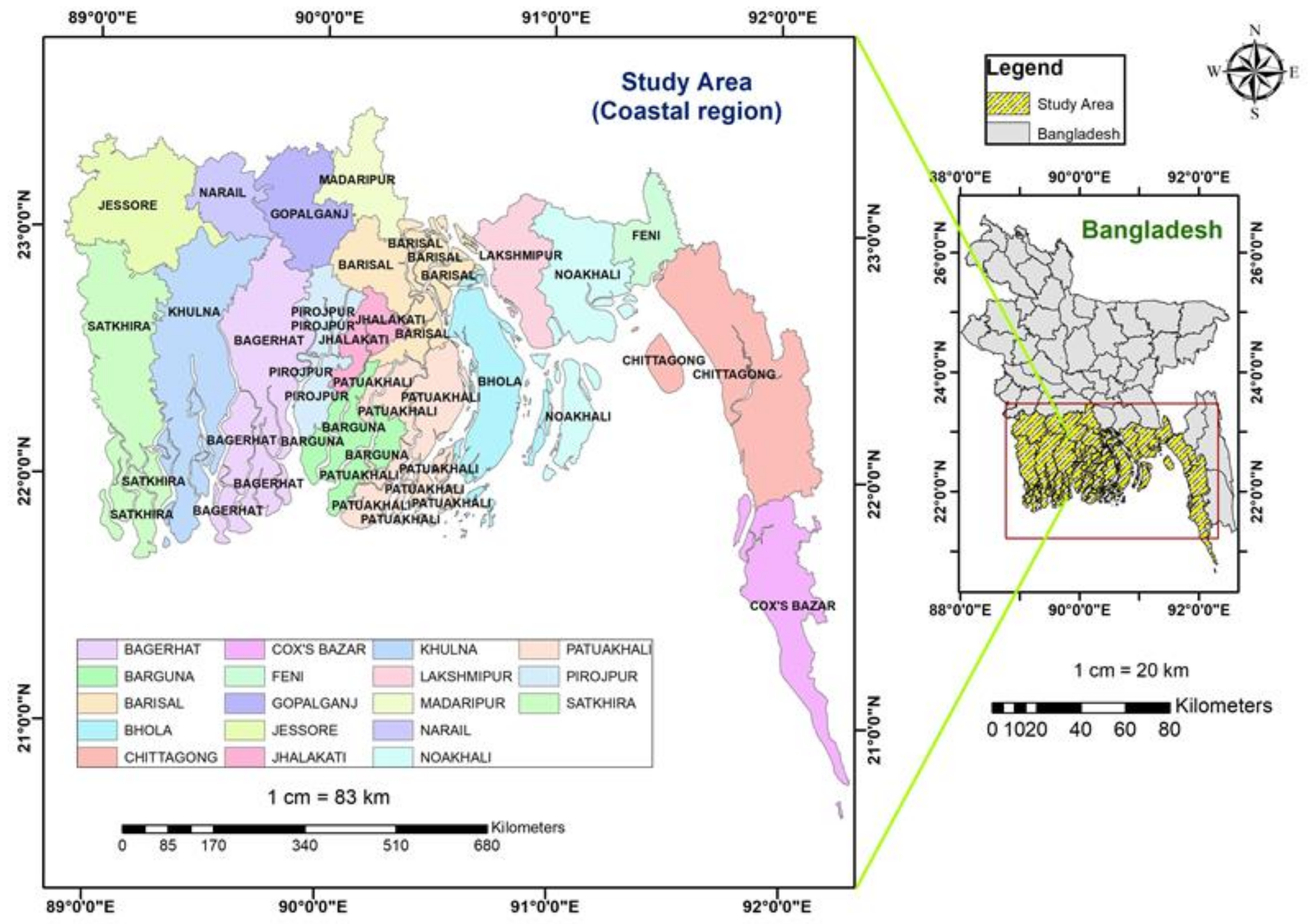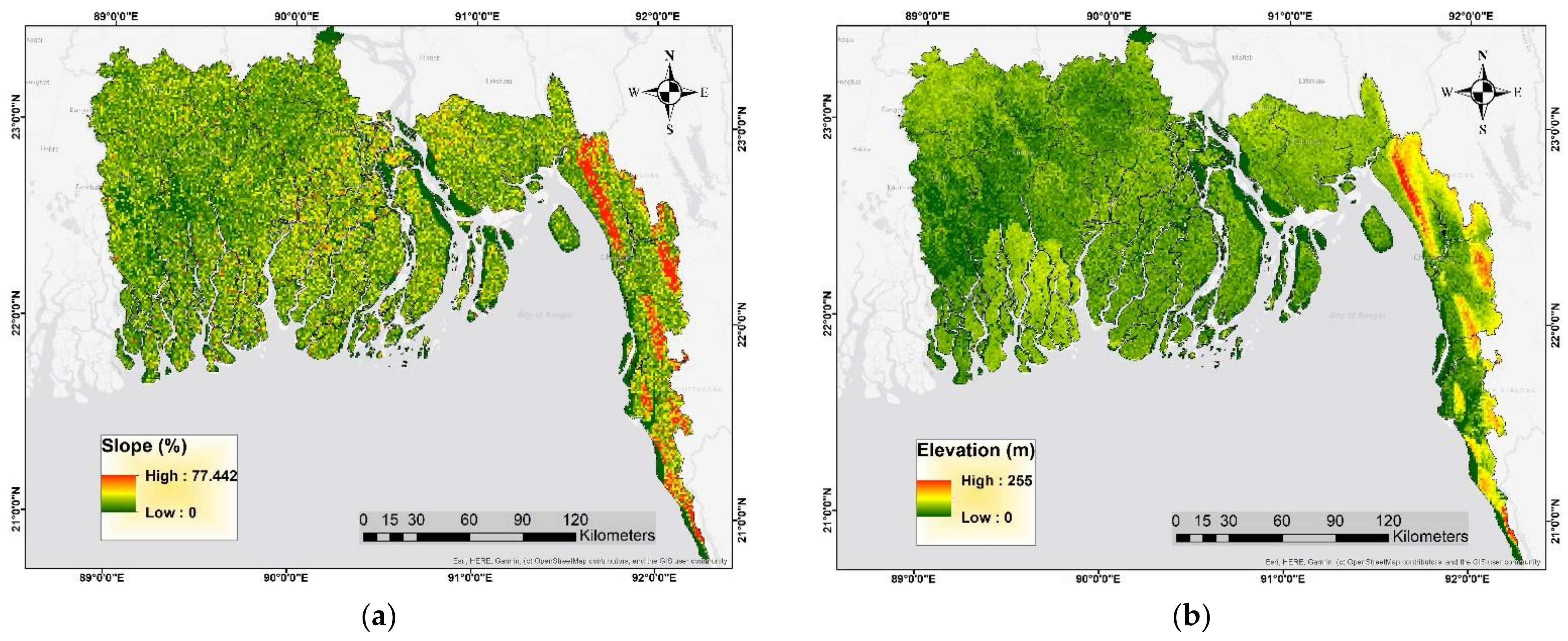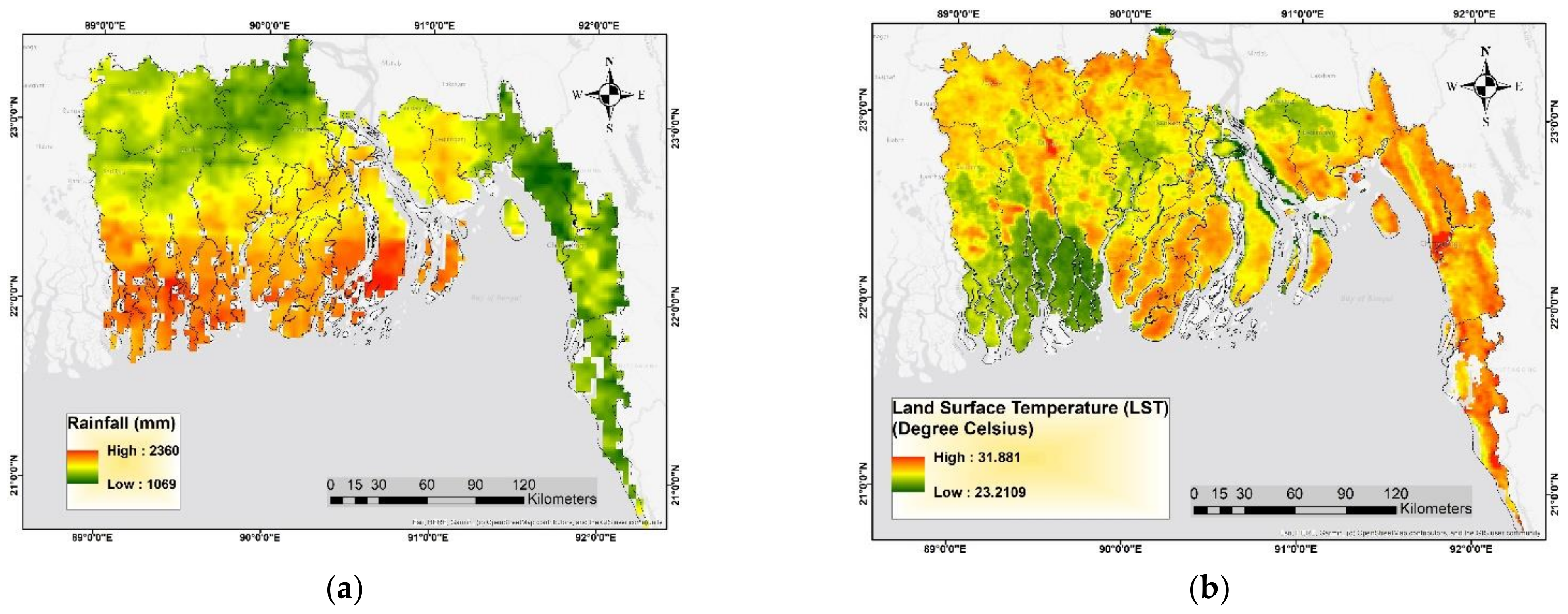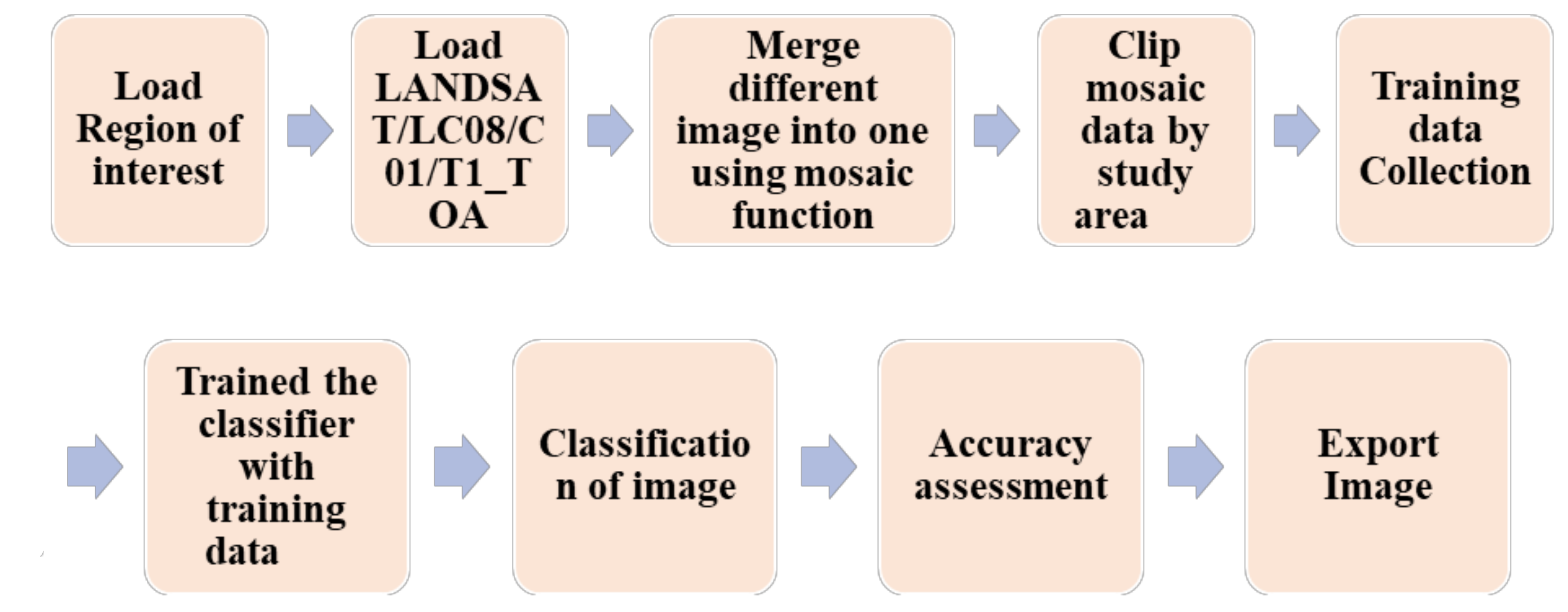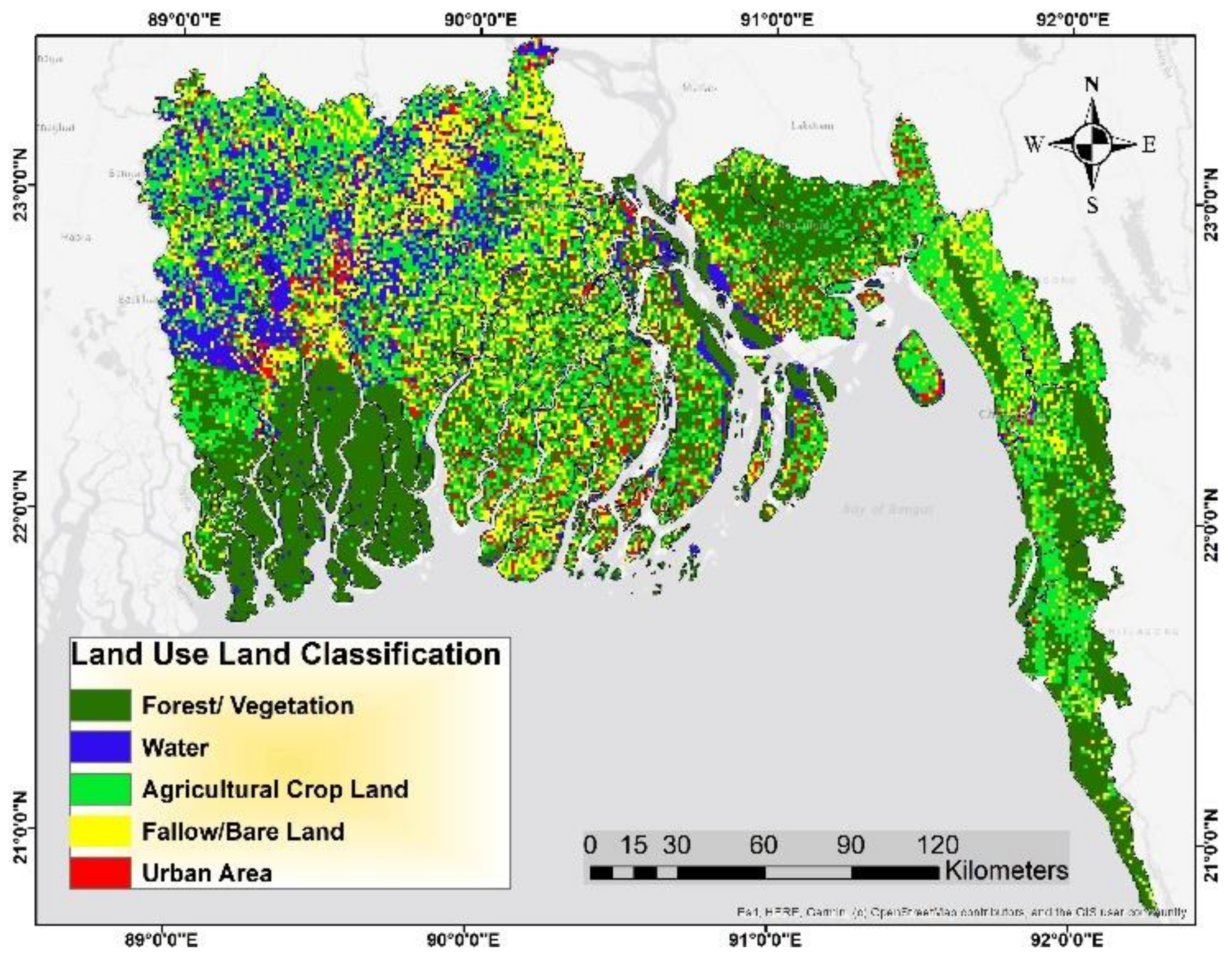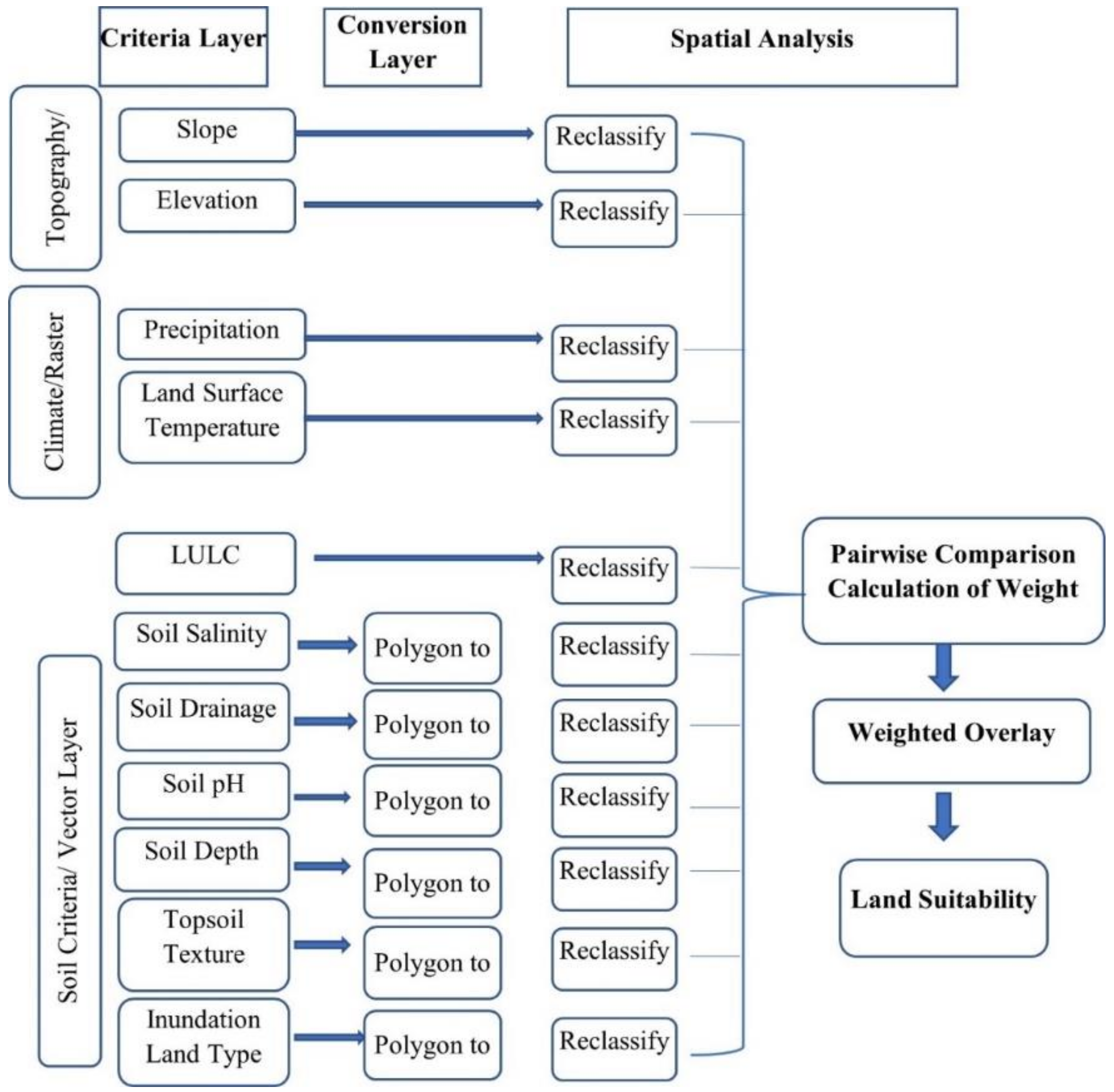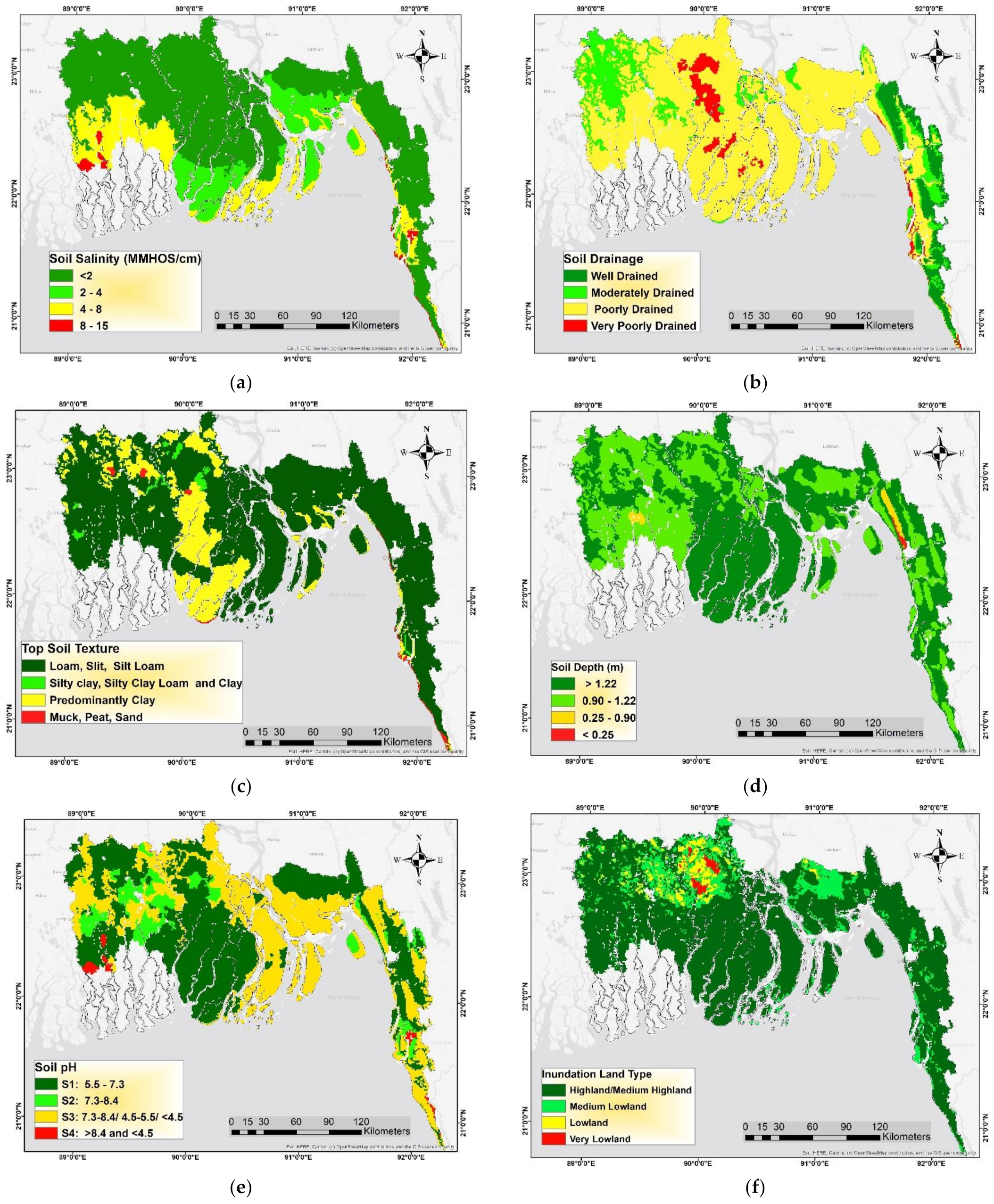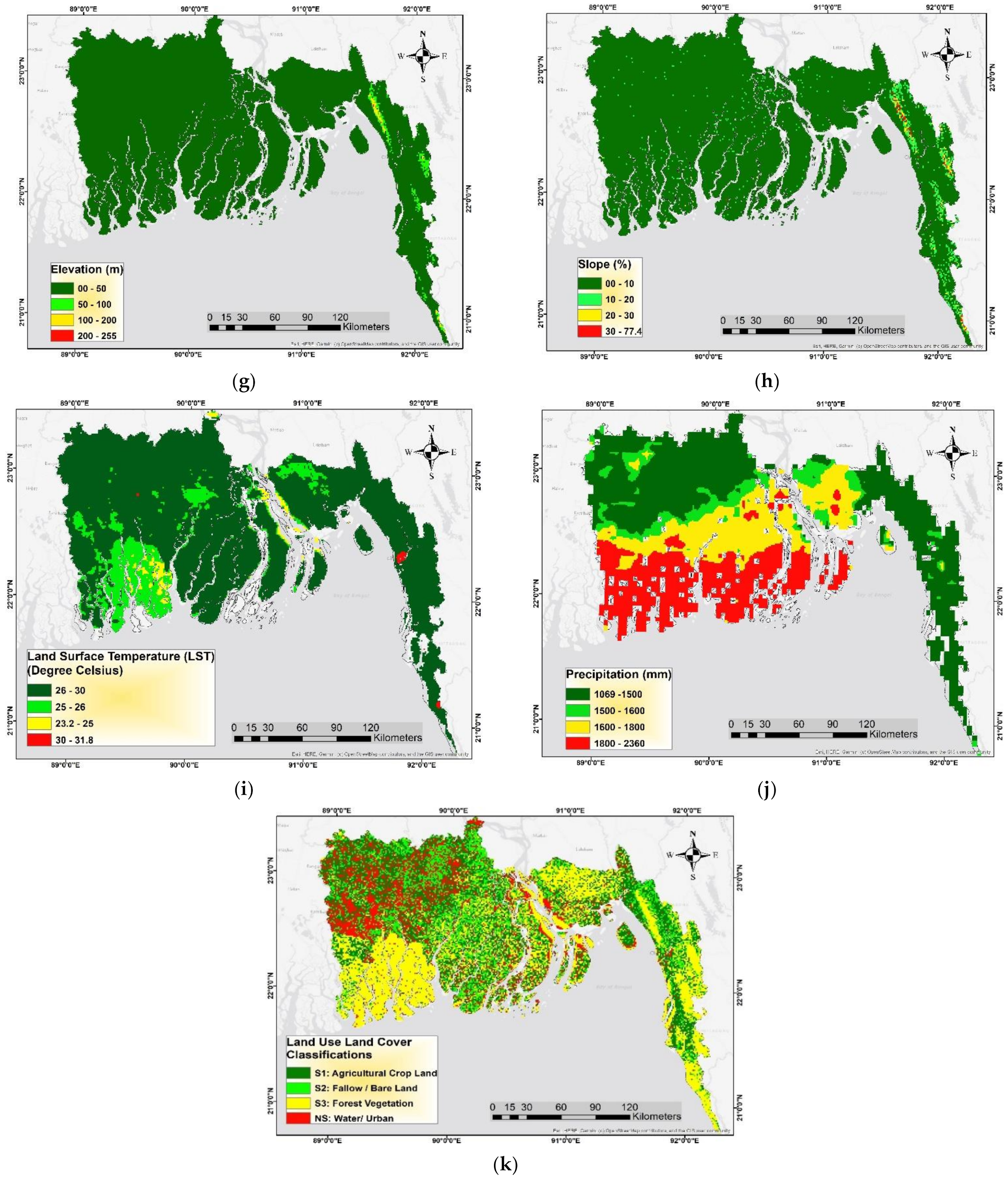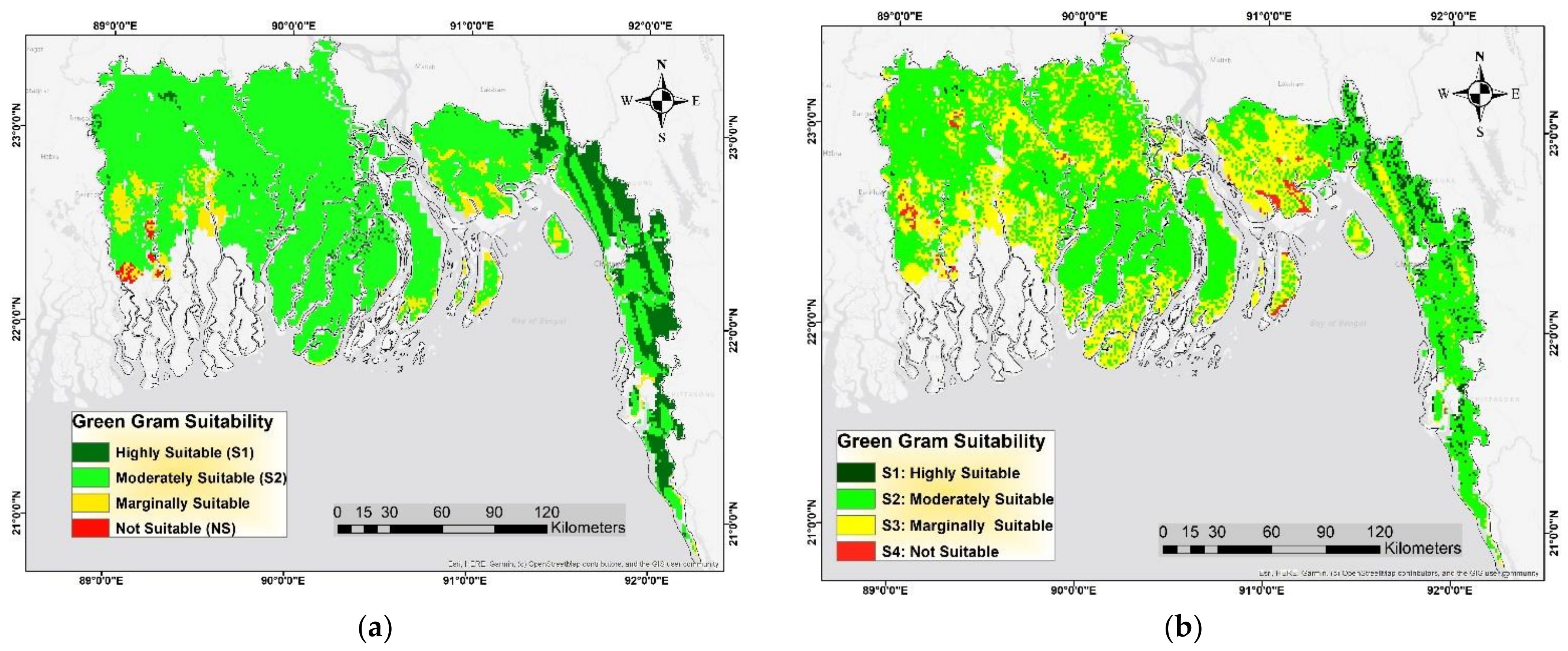1. Introduction
Bangladesh, due to its geographical location and social circumstances, is one of the world’s most disaster-prone countries [
1,
2,
3,
4]. Various natural disasters, such as intense rainfall, cyclones, flooding, thunderstorms, tornadoes, storm surges, salinity intrusion, and others, have already occurred in this country, and the intensity of these disasters has been rising in coastal Bangladesh [
5]. Coastal areas are more vulnerable to disasters than other parts of the world [
6]. These hazards may lead to a variety of socioeconomic consequences in coastal areas, including loss of property and coastal habitats, reduced agricultural productivity, loss of tourism, transportation, recreation and industry, and harbor activities [
7,
8]. Non-climate stressors, such as urbanization, population migration, land-use change, pollution, and gender problems, have also been strong drivers of changes in coastal agriculture around the world. These will, in turn, have an effect on the long-term viability of coastal food security [
9,
10,
11].
Green gram (
Vigna radiata) is one of the most popular pulse crops, grown on more than six million hectares of land across the globe—representing around 8.5 percent of the global pulse cultivated area. The green gram is extensively cultivated in many Asian countries, primarily India, Bangladesh, China, Pakistan, and some Southeast Asian countries, as well as in dry regions of southern Europe and warmer regions of the USA and Canada, owing to its characteristics—such as the short duration crop (around 70 days), low-input crop, and drought tolerance [
12,
13]. Green gram serves as a rich source of protein, containing 14.6–33.0 g/100 g protein and 5.9–7.6 mg/100 g iron [
12]. Green gram is a popular food for low-income people, especially those who cannot afford animal protein, as its production cost is low. Vegetarians also consume it as a good protein in their diet [
13]. Green gram, a plant-based protein, contributes substantially to reducing the effects of climate change, as plant protein generates considerably less greenhouse gas than animal protein. Plant protein production is also less expensive in terms of land and water demand than animal protein [
14]. So, the cultivation of green grams in the coastal area would be part of the climate change adaptation process through the improvement of soil health and environment and, at the same time, ensuring food security.
Green gram cultivation is dominant in some coastal districts of Bangladesh compared to other parts of country. During the period of 2016–17 to 2019–20, the average annual production of green gram was 56,785 MT from the coastal area of Bangladesh, while the country’s total production was 52,220 MT [
15]. This figure implies that farmers of the coastal region are traditionally growing green gram over the years. However, the amount of production cannot meet the country’s growing demand. In the year 2017, Bangladesh spent 143.2 thousand USD on importing 322 thousand MTs of green gram (mung bean) from abroad [
16]. Bangladesh also exports green gram to some extent. In 2019, the figure for export was the highest; the export value was US
$1.82 million, with a volume of 1.04 million MTs [
16]. The government of Bangladesh has been trying to extend the area of green gram production since 2014, especially in the disaster-affected areas, providing various production inputs, incentives, and subsidies to farmers to enhance the yield [
15]. There is little scientific research to identify the best suitable area for green gram production. Rather, the government’s subsidies and farmers’ cultivation are based on traditional knowledge. Accordingly, the maximum outcome has failed to provide the highest possible input. Along with the significance of the rise in soil salinity, soil health, which is the prime determining factor of crop cultivation in the coastal areas, has been deteriorating over the years. As a consequence, agricultural crop production, particularly rice cultivation, is sharply decreasing. So, there is a potential scope to investigate whether green gram can be produced. The identification and delineation of suitable areas for growing green gram have become critical, so that the government can give more focus and make more appropriate subsidy policies to boost green gram production, improve the environment, and ultimately reduce its import dependence by increasing domestic production.
To ensure the security of national food, recent land-use technology such as GIS and remote sensing has not been widely used in Bangladesh’s agriculture, particularly in the coastal region. Accordingly, individual crop cultivation, with its potentiality in Bangladesh, requires an extensive land suitability analysis. There are very few GIS and remote sensing-based land suitability studies performed in Bangladesh, and those that exist are mostly for rice production for a specific district. No land suitability studies have been found for green gram production for the whole coastal area. Due to an increase in the spatial and spectral resolution of the sensors, satellite remote sensing has advantages, allowing the discovery and documentation of new archaeological features and sites all over the world [
17]. The benefits of remote sensing mapping include a greater area coverage, a low cost, and comparatively high productivity [
18,
19]. High-resolution imagery (Landsat-8, Sentinel-2, Gaofeng-1) has become the primary source of crop area data in recent years [
20,
21].
Land assessment map analysis techniques have been achieved using geographical information systems (GIS) and remote sensing as a result of advancements in information and communication technology [
22]. In addition, the Analytical Hierarchy Process (AHP), which has the advantage of incorporating expert views to prioritize the criteria according to weight in consistent judgments with GIS, are used to consider the influencing criteria for increasing green gram production. The AHP method, based on remote sensing and GIS, is extensively used in spatial decision-making processes, such as land suitability analysis for cassava [
23]; crop insurance premiums based on land suitability [
24]; investigating drought hazard using microwave and infrared datasets [
25]; mapping of flood hazard areas [
26]; site suitability for aquaculture [
27]; and site selection for industrial, landfill, and biodigester [
28,
29].
Land suitability assessment is highly needed for productive planning and long-term land use in climate-vulnerable countries. It is crucial because it provides information on the potentials and limitations of land for a specific land use type in terms of crop performance. Land suitability analysis, according to Halder [
30], is a method of land assessment that evaluates the level of appropriateness of land for a specific use. Cropland suitability analysis is a crucial step in ensuring that the available land resources are used to their full potential in order to practice sustainable agricultural production [
30,
31]. GIS is one of the most important methods for mapping and analyzing land-use suitability. Several criteria are required for land assessment, including various soil properties, land use land cover (LULC), slope, elevation, rainfall, and temperature. Different criteria, such as geology and biophysical components (i.e., geology, soil characteristics, relief, atmospheric conditions, and vegetation), as well as economic and socio-cultural conditions, are considered in a multicriteria assessment of land suitability [
32]. The primary goal of land assessment is to determine the best land use for each specified land unit while also promoting environmental resource conservation for future use [
33]. Many researchers have attempted to develop a standard framework for the most appropriate and efficient use of agricultural land. The Food and Agriculture Organization (FAO) [
34] developed a framework for land evaluation, dividing the land into four classes, namely: highly suitable (S1), moderately suitable (S2), marginally suitable (S3), and not suitable (S4) (NS).
The Analytical Hierarchy Process (AHP) method, which was developed in the 1980s and introduced by Saaty in the mid-1970s, is one of the best methods for performing land suitability analysis [
35,
36]. AHP has been used in a variety of fields around the world, including government, enterprise, industry, healthcare, and education [
37]. Because of its ability to integrate a large amount of heterogeneous data, GIS-based AHP has become popular in research, and obtaining the necessary weights for analysis can be relatively simple, even for a large number of criteria [
31].
The primary purpose of this study is to investigate and determine the suitable land area with four suitability classes: highly, moderately, marginally, and not suitable, through GIS and considering expert opinions for green gram cultivation in the coastal region of Bangladesh. This suitability analysis could help the government make an effective subsidy program for crop production to enhance food security. This study could be a model for searching the appropriate site or land area to cultivate specific agricultural crops. Overall, it will facilitate the policymaker and agricultural extensionist in their land-use planning, to maximize the land use and achieve a sustainable agriculture in the southern area of Bangladesh.
4. Discussion
This study examined the suitable land for pulse (green gram) production in coastal Bangladesh, and this section will describe the suitable land area with some important criteria based on the study results.
The suitability level of each reclassified criteria significantly affects in the final green gram suitability. Soil salinity, soil drainage, soil pH, and topsoil texture are important criteria among them. In terms of soil salinity, it is found that the salt concentration is very high in the southwestern coastal site. The land area, which is very close to the coast, is highly affected by soil salinity. This is due to the fact that natural disasters enhance this salinity intrusion. The salt concentration in the soil might impair the nutrient uptake by the plant and eventually deter the growth and development of the plant. Salinity is expected to reduce crop production in up to 20% of irrigated lands around the world, and this loss will rise to about 50% of arable land by the mid-twentieth century [
66]. Several studies have recently shown that soil salinity stress reduces the physiological attributes of crops like mung bean (
Vigna radiata L.) [
67]. Hence, an increase in soil salinity implies a decrease in the suitability for crop production.
Soil drainage conditions directly affect the growth and development of crop plants. Agricultural soils need good drainage conditions to increase agricultural crop production by maintaining the water sources [
68]. This plays a key role in aeration in the root system, affecting crop growth. The majority of the study area is not well-drained soil, and is thus highly prone to water stagnation, which inhibits green gram cultivation.
Soil texture is a physical property and a significant factor in crop development and field management [
69]. The coastal area of Bangladesh contains predominantly loam, silt, and silt loam soil, which is a very favorable soil condition for any kind of plant production, including green gram. Few areas in the eastern part contain muck and peat soil, and green gram cannot be produced in that kind of soil.
Soil depth also has a significant effect on green gram cultivation. Root penetration may be physically limited by any discontinuities in the soil profile, from sand or gravel layers to bedrock. When using irrigation, it can also cause issues. To grow and increase physical fertility, soil macro- and mesobiota need sufficient soil [
70]. Most of the coastal area is found to contain well-depth soils.
In the case of soil pH, alkaline soil is found at almost every corner of the study area, which is not a favorable condition for green gram production. The middle part of the study area, including the Barishal region, contains predominantly alkaline soils, with a pH value greater than 7. Soil pH is one of the most important factors affecting the plants’ absorption of trace elements, with a higher soil pH resulting in higher adsorption (and thus lower availability) [
71,
72,
73,
74]. High land (HL), medium high land (MHL), medium low land (MLL), low land (LL), and very low land (VLL) are the five inundation landforms in Bangladesh [
75]. The majority of the study area is covered with high land to medium high land. Low land and very low land are highly vulnerable to floods, which leads to significant crop losses.
As regards the topography, the slope is considered as the most important parameter for land suitability studies for agricultural crops in all areas. Usually, slope contributes indirectly to crop cultivation. When it comes to mechanization, slope, an integral feature of landform, plays a significant role. The only land with a slope of less than 8 degrees should be used, according to Navas and Machin [
76], to prevent soil erosion and other problems associated with the use of machinery. Green gram is highly suitable at a slope of 0–10 percent, moderately suitable at 11–20 percent, slightly suitable at 21–35 percent, and not suitable at slopes above that percentage, according to Grealish et al. [
77], in an Australian analysis on the soils and land suitability of agricultural growth areas.
Generally, higher elevations are less suitable for mung bean production, and vice versa. Green gram grows best at the height of 0–1600 m above the sea level [
78], with a maximum elevation of 2000 m [
78,
79]. Higher annual mean rainfall is found in the seashore line, while a comparatively lower rainfall, considered a favorable condition, is observed mostly in areas distant from the coastline. A suitable land surface temperature is observed in almost all parts of the study area. Mung bean (green gram) is a warm-season crop, which can be cultivated in temperatures between 20 and 40 degrees Celsius [
80]. However, seed germination and plant growth are best at temperatures between 28 and 300 degrees Celsius [
80,
81,
82].
From the final green gram suitability map, it is found that only 12 percent of the land area is highly suitable for green gram production. This is due to the fact that a significant land area is affected by soil salinity, and the majority of the area contains a poorly drained soil. These two parameters have a remarkable impact on the decision-making process. According to the AHP analysis (weighted overlay process in ArcGIS), the weight of their was 29% and 19%, respectively. From the spatial distribution point of view, it is found that the highly suitable area belongs mostly to the eastern part of the country. This spatial distribution of highly suitable land also coincides with the spatial distribution of the “agricultural crop land” class in the land use land cover map, where agricultural cropland is found above all in the eastern part of the country. Additionally, from the above discussion, it can be concluded that the eastern part of the study area is highly suitable in terms of all criteria considered, when compared to other parts of the area. The impact of the weights of the criteria can be measured by the sensitivity analysis and consequently provide a validation of the GIS-based multicriteria decision-making model. In sensitivity analysis, when the weight is changed for the criteria, the final suitability results also change. The areas with different levels of suitability are significantly altered when equal weights are assigned to each parameter.
5. Conclusions
In order to ensure the food security of the coastal region of Bangladesh, a land evaluation system is required to find out the potential land area for the cultivation of a specific crop. This study was carried out to find out the best potential land for pulse (green gram) crop cultivation in the coastal region of Bangladesh. The study used GIS and remote sensing with multicriteria analysis while considering 11 parameters associated with topography, climate, and soil. The study identified soil salinity as a major problem or constraint for pulse production, with the highest importance (30%). Another important parameter is soil drainage, with a weight of 19%, causing a decrease of the area belonging to the highly suitable class. In the final assessment, it is found that only 8.36% of the study area is highly suitable (S1) land, while the largest area, representing 74% of the land, is moderately suitable (S2). Along with a higher weight value, a poor soil drainage condition covering more than 73% of the land results in less land area in the highly suitable (S1) class in the final suitability map. Additionally, it is observed that the highly suitable (S1) land area belongs mostly to the southeastern part of the country.
The results of this study can be of great importance for policymakers of the agriculture ministry of Bangladesh, as they will help them formulate and implement the necessary policies to optimize pulse production. The government should prioritize the southern part—Chittagong, Cox’s Bazar, and Noakhali districts, for example—to enhance green gram cultivation by providing incentives such as seed, fertilizer, etc., to the farmers, and avoid the peripheral coastal area. In addition, the government, donor agencies, and NGOs need to implement strategies to reduce soil salinity and improve soil drainage to improve pulse production. This study can be used as a model for land evaluation in many other agricultural crops in the country and abroad.
